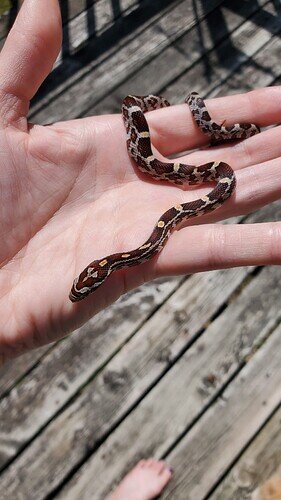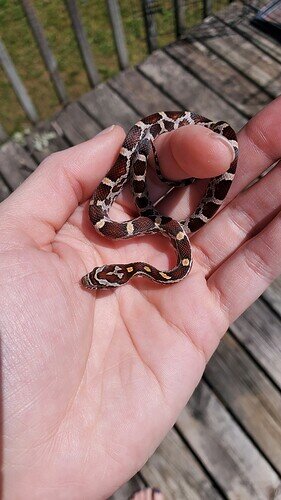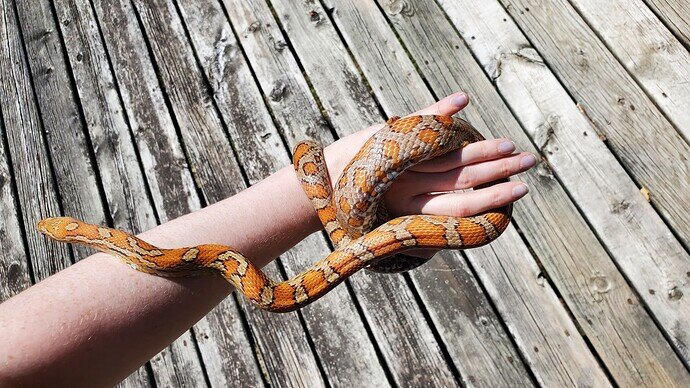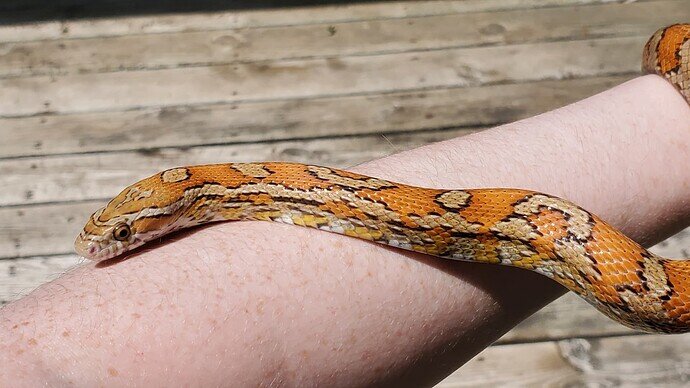Everyone is out! Today I recorded all the weights, suspected genders, and moved the babies into a temporary communal enclosure. It is looking like possibly 6.4 on genders, though I’m no expert on sexing. Seems both Leaky and the other Amel are males, which is a bit of a bummer, but hey, they are still beauties!
Hooray for everybody having emerged. I’m curious, how did you determine possible genders?
Technically should have used the word sex instead of gender considering proper definitions. 
Sexed via looking at the tails. I know this isn’t as accurate as probing, but there are subtle differences that make it clear in the majority of cases. I will be separating them in to suspected same sex pairs, then having their sheds DNA tested to confirm
Ah. Just wondered. I don’t personally try to guess using tail morphology on hatchlings/juveniles. Do you get a group price for DNA of sheds?
I generally pop babies. Those who pop as definitely male are done. I don’t mark them female until they’ve been tried three times and not popped male. The exception is the light colored morphs like Leaky. I candle those, though I generally still confirm once by popping.
I’ve not been too bad at it thus far, so it’s what I go with since I am not skilled enough to pop them confidently. I don’t want to hurt them. As for group pricing, 6-10 babies only knocks $1 off per test, so I’m still looking at $150ish to test them all.
I’m not bad at tail- guessing once they’re past snake puberty, lol. Sounds like you’re better at doing that with babies than am I. I think the DNA tests are cool but I think I’ll stick with sexing mine with the old school gentle pressure for popping, aided by candling on the light babies.
Moved everyone into their baby bins today. I’ve got them in pairs to make keeping track of feeding easier. Offered them all their first meals and half the clutch ate on the first go, including Leaky and his bin mate. Totally forgot, however, that I was dang near out of pinkies, so I made a quick order of more feeders. I can’t wait until they start shedding, some of them have serious potential to be gorgeous snakes.
Now I feel I need more pictures!! 
Such pretty babies, congrats! 
I always breathe a sigh of relief once they get those meals into them. I’m confused though. Are you feeding them before they’ve shed?
I believe in offering them food once they’ve hatched, and not waiting until they shed. Considering they’re on their own immediately after hatching, were they not captive bred, I figure it’s a more natural approach. Any babies that ate did so willingly, either off tongs/out of my fingers or immediately after the pinky was placed in the bin. Anyone that showed no interest had the food removed as to not cause issues.
I figured, I can research myself to death and there will still be multiple answers for each step of this process. Since we don’t know everything about their behaviour in the wild, I am kind of freestyling a bit for my first season to see what works best for my keeping style. Letting the babies be my guide.
I was just curious.
That is definitely true. There’s very seldom only one “right” way to do things. There are a few things which are really “wrong” in that they’re truly unsafe, harmful, or unethical. Most of the time there is room for variation to suit individuals, human or otherwise.
I tend to fully explain my thinking, regardless. Sorry, sometimes it seems like I’m being defensive when I’m just documenting my process for myself as well.  I don’t have the best long-term memory, so when I have a good think about why I do a thing, I like to write it down.
I don’t have the best long-term memory, so when I have a good think about why I do a thing, I like to write it down.
Still only five babies took meals, though I’m not surprised since a few are so blue they couldn’t see the pinky, anyways.  Thank goodness for the trusty garbage disposal noodle (sub-adult) who took all the leftovers. I will likely add more photos once they start shedding, the patterning on a few is already very interesting and I can’t wait to see it after!
Thank goodness for the trusty garbage disposal noodle (sub-adult) who took all the leftovers. I will likely add more photos once they start shedding, the patterning on a few is already very interesting and I can’t wait to see it after!
Same here, no worries at all. Between being a mom and being a teacher, not to mention ao person who talks to pets and plants, I’ve definitely got a tendency to narrate and (over)explain everything.
Looking forward to seeing your babies post-shed soon!
Beautifully rich color! Looks like a calm baby, too, which is a lovely bonus.
Pretty calm, yes. I honestly can’t wait to see this one grow, the little light flecks in the dark bits of the side walls are interesting. Wonder what they’ll look like down the line.
Did I ever mention the genetics on these normals? They’re either:
Miami-influenced Normal
100% het Scaleless
66% pos het Amel
or
Miami-influenced Normal
100% het Anery, Hypo
66% pos het Amel
50% pos het Motley, Stripe
pos het Diffused, Lavender, Scaleless
For the Amels, just replace the “Normal” with Amel and scratch the “66% het Amel”.
Quite the toss up there.
Quite! I can see the Miami influence, there. The light areas in the side “diamonds” remind me of patterns in some Western blankets or weaving. I always appreciate those. Corn snakes really are beautiful.






